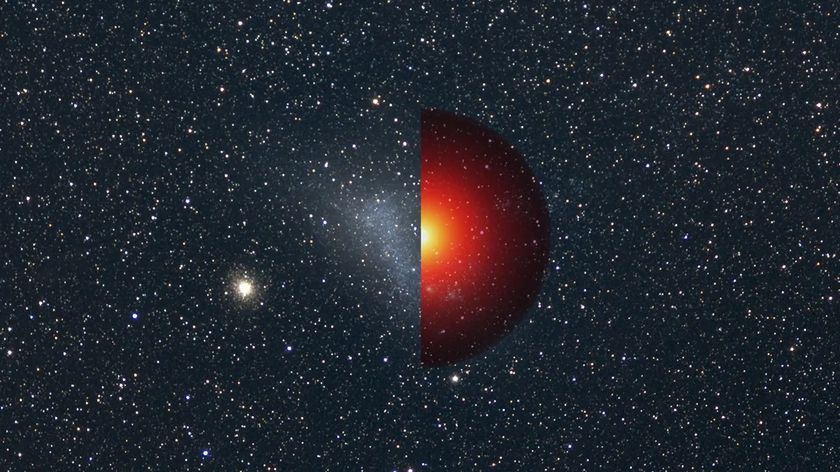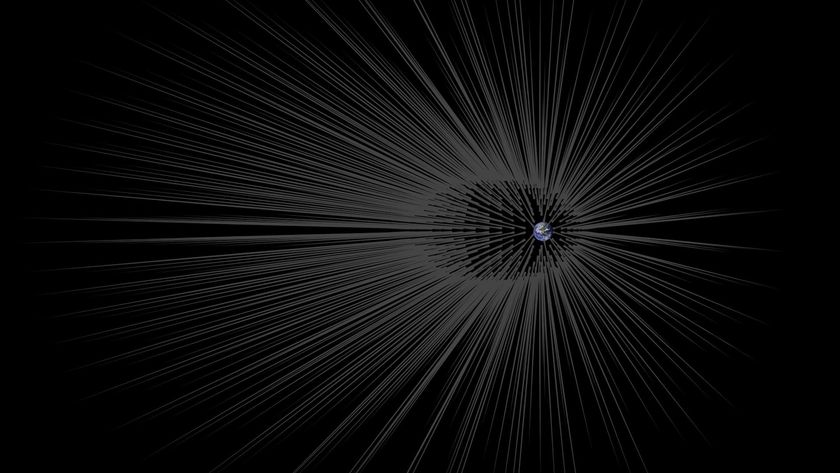New Kind of Dark Matter Could Form 'Dark Atoms'

The mysterious dark matter that makes up most of the matter in the universe could be composed, in part, of invisible and nearly intangible counterparts of atoms, protons and electrons, researchers say.
Dark matter is an invisible substance thought to make up five-sixths of all matter in the universe. Scientists inferred the existence of dark matter via its gravitational effects on the movements of stars and galaxies.
Most researchers think dark matter is composed of a new type of particle, one that interacts very weakly at best with all the known forces of the universe save gravity. As such, dark matter can almost never be seen or touched, and rarely even collides with itself. [Gallery: Dark Matter Across the Universe]
This might not hold true for all forms of dark matter, though. Now, some researchers suggest a new kind of dark matter could exist, representing about one-fifth of all dark matter in the universe, making it potentially as plentiful as conventional matter.
Dark atoms
"There is no good reason to assume that all the dark matter in the universe is built out of one type of particle," study author Andrey Katz of Harvard University told SPACE.com.
These new dark matter particles would essentially consist of heavy "dark protons" and light "dark electrons." They would interact with each other far more than other dark matter particles to form "dark atoms" that use "dark photons" to interact through a sort of "dark electromagnetism," much as regular protons and electrons interact through photons in conventional electromagnetism to build the atoms making up the stuff of everyday life. If dark atoms are possible, they could react with each other for dark chemistry, much as regular atoms interact chemically.
Sign up for the Live Science daily newsletter now
Get the world’s most fascinating discoveries delivered straight to your inbox.
"The dark world might even be as diverse and interesting as the visible world," Katz and his colleagues wrote May 23 in the journal Physical Review Letters.
The interactions between dark protons and dark electrons could make them lose energy over time. As such, they might slow down enough to clump into flat disks around galaxies, just like regular matter does. In contrast, most dark matter apparently forms roughly spherical haloes around galaxies, stars and planets.
This concept means galaxies would have two disks, one made of regular atoms and one of dark atoms, which is why the investigators call their idea the double-disk dark matter model.
"The double-disk dark matter idea is a novel twist on an intriguing concept — that the physics of dark matter might be as complicated and interesting as the physics of ordinary matter is known to be," said theoretical physicist Sean Carroll of the California Institute of Technology, who did not take part in this study.
Carroll and his colleagues had earlier suggested "the basic possibility of a dark force very similar to electromagnetism — a long-range force with positive and negative charges," he said. "Such a model implies dark radiation, dark magnetic fields, and a host of other interesting phenomena. But we only had one kind of dark-matter particle in our model; to go to the world of dark atoms and dark chemistry requires more kinds of particles. That's the direction the new papers are taking."
The gravitational effects of a dark atom disk on stars in galaxies could eventually be detectable via the European Space Agency's Gaia space observatory scheduled to launch in October, which aims to map the movement of approximately 1 billion stars in the Milky Way.
"This is how we might first detect this dark disk," Katz said.
Moreover, since this novel form of dark matter is expected to be much slower on average than regular dark matter, it should be more susceptible "for capture by the Earth, by the sun, or other heavy celestial objects," Katz said. "Annihilation of this dark matter captured by the sun can result in neutrino fluxes, which can be measured directly by the IceCube Neutrino Observatory on the South Pole."
In addition, the dark electrons and dark protons the scientists propose might also have antimatter counterparts — dark anti-electrons and dark anti-protons. When these particles collide with their counterparts, they would release gamma rays, the most energetic form of light, which telescopes should be able to spot. Furthermore, dark atoms might also have formed clouds of dark plasma, ripples in which might have influenced the formation of the early universe and thus have visible effects on large-scale cosmic structures that exist nowadays.
"Theories of dark matter with new forces provide a wonderful playground for theorists to develop new models of particle physics," Carroll said. "The hard part will be getting the astrophysics right — how does the dark matter evolve and cluster? In the observable world, the presence of electromagnetic fields makes that a very hard problem — when you add dark electromagnetism to the mix, it will only get harder!"
This story was provided by SPACE.com, a sister site to LiveScience. Follow us @Spacedotcom, Facebook and Google+. Original article on SPACE.com.













